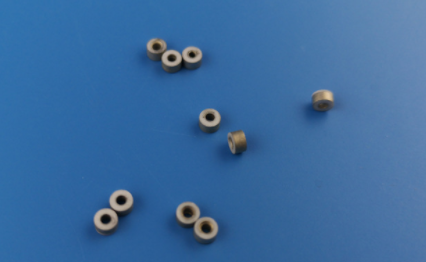1. Types of magnesia porcelain
Magnesia porcelain is a ceramic with MgO-containing aluminate and silicate as the main crystal phase. According to the main crystal phase of the porcelain body, there are four types: talc porcelain, forsterite porcelain, spinel porcelain and cordierite porcelain.They all belong to the MgO-Al2O3-SiO2 ternary system. Talc porcelain is used in general high-frequency radio equipment, such as radar, television, it is used as insulation parts, magnesium peridot porcelain dielectric loss is low, larger than the volume resistance, can be used as high-frequency insulation porcelain. Cordierite has a low coefficient of thermal expansion and good thermal stability. It is used as an insulating or heating material requiring a volume that does not change with temperature.
2. Manufacturing technology of talc porcelain
(1) Composition of talc porcelain
The basic composition of general talc porcelain is MgO·SiO2 and forsterite (2MgO·SiO2) near the phase boundary curve of magnesium metasilicate (MgO·SiO2) and SiO2 in the MgO-Al2O3-SiO2 ternary system.The main raw material of talc porcelain is talc. In order to improve the processing performance of raw materials and the quality of porcelain pieces, some admixture has been introduced.
(2) Prefiring of talc porcelain
The prefiring process of talc is one of the key factors in production. The pre-firing temperature and transition degree depend on the type and amount of mineralizer. To reduce the pre-firing temperature, mineralizers such as boric acid, barium carbonate, or kaolin can be added.
(3) Sintering of talc porcelain
The key to sintering talc porcelain is to expand the sintering scope and strictly control the furnace temperature system. Because talc porcelain produces a liquid phase fast and has a low viscosity at high temperature. Therefore, the sintering temperature is usually between 1300~1350℃, and the sintering range is narrow. It is required to control the temperature at the lower limit of the waveization range. Do not overfire. The holding time should not be too long, preferably within 1h. The furnace temperature is uniform and easy to control.

Talc porcelain products
3.Overview of forsterite porcelain
(1) Manufacturing process characteristics
The main technological characteristics of forsterite porcelain: the blank has good plasticity and is easy to form. The sintering temperature is 1250~1350℃, and the sintering temperature range is about 60℃ or more. In order to improve the processing performance of the blank and reduce the sintering temperature, clay or additives such as barium bisborate, zinc oxide, barium carbonate, calcium carbonate, etc. are often added to the formula.Their function is to reduce the sintering temperature. Barium oxide and boron oxide have the strongest ability, followed by zinc oxide, barium carbonate and calcium carbonate.
(2) Performance
The main characteristic of forsterite porcelain is low dielectric loss, and it becomes smaller as the frequency becomes smaller, and does not increase in the microwave range. Its specific volume resistance is very high, and still has a fairly high value at high temperatures. When the temperature rises to a very high above 1000 ℃, it still remains above 104Ω·m, and its electrical properties are better than that of talc porcelain. Another characteristic of forsterite porcelain is that its thermal expansion coefficient is similar to that of some glasses, alloys (such as Ni-Fe alloy) and metallic titanium. it is convenient for metal-ceramic sealing and is widely used in the manufacture of electric vacuum devices. But its thermal stability is poor because of its high coefficient of thermal expansion.
4. Magnesium spinel porcelain
(1) Manufacturing process of magnesium spinel porcelain
The main crystal phase of magnesium spinel porcelain is MgO·Al2O3, and its theoretical composition point is very close to the lowest co-melting point, so it is difficult to burn. It is usually necessary to first synthesize spinel frit, then take frit as the main component, add a small amount of clay and B2O3, CaF2, SiO2 and other additives to reduce the firing temperature. The sintering temperature of magnesium spinel frit is 1450~1600℃, and that of spinel porcelain is about 1360℃.
2) Properties and uses of magnesium spinel porcelain
Magnesium spinel porcelain is a kind of dielectric ceramic with lower dielectric loss than talc porcelain, but with slightly higher dielectric constant and good chemical stability. In the electronics industry, it is a good material for low-voltage and high-frequency capacitors, induction coil frames, and tube sockets.
5. Cordierite insulating porcelain
(1) Manufacturing process of cordierite insulating porcelain
In the manufacturing process of cordierite insulating porcelain, the main problem is the narrow sintering range. When the temperature is 1300~1400℃, the formation rate of cordierite is very slow. When it reaches 1450℃, the cordierite will melt and decompose into mullite and glass. It can be seen that its sintering temperature is only a few degrees from the decomposition temperature, so it is difficult to sinter the substance dense
It can be seen that its sintering temperature and decomposition temperature are only a few degrees, so it is difficult to sinter into a dense body(substance). Using MgCO3, BaCO3, PbSiO3, ZrSiO3, ZrO2, B2O3, spodumene, etc as additives in the formulation can reduce the sintering temperature and expand the sintering range.
(2) The performance and use of cordierite insulating porcelain
The main crystal phase of cordierite insulating porcelain is 2MgO·2Al2O3·5SiO2. Because the ions in the crystal structure are not closely arranged and there are larger cavities in the crystal lattice, its electrical properties are poor, and the dielectric loss is high, which is not suitable for high frequency occasions. However, the cordierite insulating porcelain has an average linear expansion coefficient of(1~2) X10-6/℃ from room temperature to 700℃, which has good thermal stability. It is often used in places that do not require high electrical performance, but require heat shock resistance, such as heater bottom plates and thermocouple insulation materials. In addition, its acid resistance is very poor and cannot be used in sites with acid corrosion.






